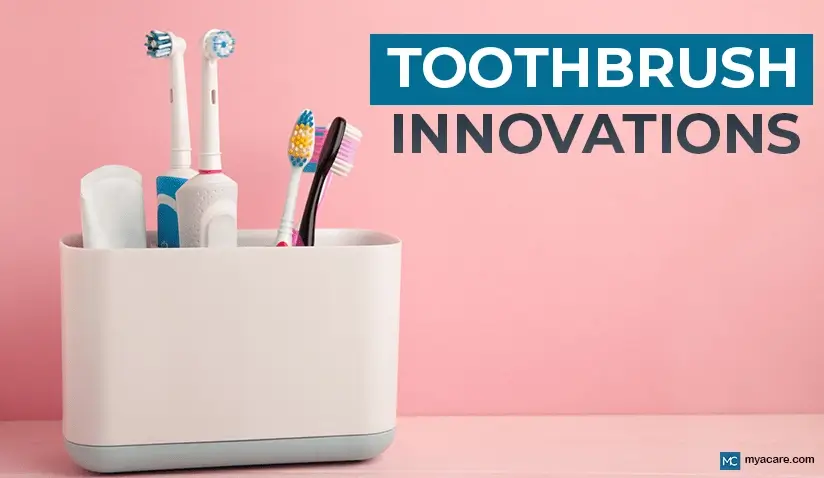The Evolution of Toothbrushes: From Bristles to Smart Technology

The Latest Toothbrush Innovations
New Toothbrush Products Launching in 2023
Things to Look for in a Toothbrush
Maintaining oral health helps keep teeth functional for life. However, one truly appreciates the importance of dental care when experiencing a toothache or undergoing hours of dental treatment. The use of a toothbrush is an effective and inexpensive way to maintain oral hygiene. Tooth brushing helps remove food residue and plaque from teeth, playing a key role in preventing oral diseases.
The bristle toothbrush, widely used today, was first made in China during the Tang Dynasty (619-907 AD). In the early 1980s, electrically powered toothbrushes were introduced to improve oral hygiene. Since then, there have been several developments, including the introduction of rotary action brushes, sonic toothbrushes, ultrasonic toothbrushes, ionic toothbrushes, and hybrid toothbrushes. Of the total global toothbrush market in 2023 (estimated to be 7 billion), electrically powered toothbrushes are estimated to account for 3 billion, growing at a 4.21% CAGR. As the adoption of electric toothbrushes increases, it is important to understand the latest innovations to make an informed decision when choosing your toothbrush.
In this article, we discuss the latest toothbrush innovations and what you should consider when selecting a toothbrush.
What are the Latest Toothbrush Innovations?
In recent years, the toothbrush has evolved into a scientifically designed tool that incorporates modern ergonomic principles, providing maximum benefits. Several varieties have emerged, including:
Oscillating toothbrushes: A major milestone in power toothbrush development occurred with the launch of the Oral-B Plaque Remover ‘D5’ and its novel prophylaxis-inspired oscillating-rotating mode of action in 1991. The brush, with its cup-shaped design, rounded bristles, and 5600 oscillations per minute, effectively removes plaque. Research has shown that oscillating toothbrushes are gentle on teeth and gums while offering superior cleaning efficacy compared to manual brushing. Recent electric oscillating toothbrushes launched in 2022 include the Oral B iO series 4, 5, and 10.
Smart toothbrushes: In 2007, the Oral-B Triumph with Smart Guide introduced clinically proven combined oscillating/rotating/pulsating technology along with an innovative wireless remote display feature (Smart Guide) for continuous visible brushing feedback. These toothbrushes can be paired with smartphones, tablets, and other Bluetooth-enabled devices, allowing users to receive real-time feedback on their brushing techniques and track their oral care habits over time.
Sonic brushes: Sonic power toothbrushes have evolved since their introduction in the early 1990s. Oral-B introduced the Sonic CompleteTM in 2004, followed by the PulsonicTM in 2008, meeting the demand for quieter, lighter, and slimmer sonic brushes with maximum cleaning efficacy. Philips' DiamondCleanTM, recently redesigned with high-density, diamond-shaped bristles, aims to improve cleaning and whitening. In 2021, an evolution of DiamondClean Smart, Prestige 9900, was launched, featuring a timer, a reminder system for brush head replacement, and a visible pressure sensor.
Ultrasonic toothbrushes: Ultrasonic toothbrushes differ from conventional electrical toothbrushes in their higher operating frequency (>20 kHz). This frequency range is inaudible to the human ear and may be beneficial as it significantly increases hydrodynamic forces, such as the flow rate of dental fluid and the formation of bubbles.
UV toothbrushes: These devices use ultraviolet light to remove germs from toothbrushes in just 10 minutes. UV light damages the cells' DNA, effectively "killing" them and eliminating 99.9% of harmful microorganisms.
New Toothbrush Products Launching in 2023
Anticipated arrivals include oral toothbrushes like Heisr (featuring a brush head with three sides designed to clean all three tooth surfaces simultaneously in just 40 seconds), Instafloss water flosser (emitting 7 jets of water per arch simultaneously to clean both top and bottom teeth at once), Talo brush (a nylon-bristled brush capable of cleaning teeth in just 30 seconds, providing cleaning in both rows of teeth on one side of the mouth at a time), Encompass (an advancement in mouthpiece toothbrush technology), and more.
What Should You Look for in a Toothbrush?
The market has seen an influx of toothbrush options in recent years, making it crucial to choose the right toothbrush for maintaining your oral health. Your decision should be based on the following characteristics of toothbrush design:
- Head size: The toothbrush head is designed for effective cleaning of tooth surfaces. Smaller heads provide better access to different parts of the mouth. For adults, large or medium-sized heads are sufficient, while small-sized heads are recommended for children.
- Bristle design: Toothbrush heads contain tufts, which are groups of filaments anchored in holes within the toothbrush head. These filaments, within the tufts, are called bristles. Bristles of varying sizes are useful for cleaning gaps between teeth.
- Bristle firmness: Among soft, medium, and hard bristles, soft bristles are recommended, as using hard bristles with an incorrect brushing pattern can remove the enamel layer. Moreover, hard bristles can also damage gums by pulling them down towards the root, leading to tooth sensitivity when exposed to cold.
- Handle grip: The handle should be comfortable with a secure grip. Recent toothbrush models include handles with various designs, such as straight, angled, curved, and contoured grips, often with soft rubber areas for easier handling.
According to ADA specifications, an ideal toothbrush should have:
Brushing surface: A length of 1-1.25 inches and a width of 5/16-3/8 inches, 2-4 rows of bristles, 5-12 tufts per row, and 80-86 bristles per tuft.
Why is Brushing and Flossing Important?
Dental professionals recommend brushing teeth twice a day for two minutes and flossing once daily to maintain good oral hygiene. Here is why these practices are important:
- Prevent tooth decay: Brushing and flossing help remove the plaque (a slimy film of bacteria) present on the surface of teeth and gums. If not removed, the bacteria in plaque can release acids (after fermenting the food debris in the oral cavity), which can demineralize the tooth surface, causing decay. Thus, brushing and flossing can prevent tooth decay.
- Maintain gum health: The accumulation of plaque and tartar on gums can cause gum diseases. If left untreated, gum diseases can result in loosening of teeth. Brushing and flossing of teeth prevent the accumulation of plaque and tartar, maintaining the health of gums.
- Prevent bad breath: Regular brushing and flossing can effectively remove food debris and bacteria that cause bad breath.
- Maintain oral restorations: Good oral hygiene maintenance reduces the amount of bacteria in the oral cavity, prolonging the life of restorations such as fillings, crowns, veneers, and braces.
- Maintain overall health: Poor oral health is known to have a negative impact on an individual's systemic health. Thus, good oral hygiene maintenance through regular brushing and flossing of teeth can lower the risk of systemic diseases (e.g., diabetes, heart diseases, stroke).
- Saves time and money: Individuals with good oral hygiene and regular dental checkups may not require extensive treatments commonly needed by those with poor oral hygiene. This saves time, money, and the effort required for extensive dental treatments.
What are the Tips for Maintaining Oral Hygiene?
Besides regularly brushing teeth twice daily for 2 minutes and flossing once daily, one can follow the below-mentioned tips to maintain oral hygiene:
- Choose a toothbrush with soft bristles. The use of hard bristles may damage the gums and pull them away from the tooth (root) surface.
- Brush teeth for 2 minutes using fluoride toothpaste, which helps protect teeth from decay.
- Make small circular strokes while brushing or keep the toothbrush at a 45-degree angle pointing towards the gums and move the brush in a back-and-forth motion on the surfaces of teeth.
- Clean all the surfaces of teeth, including inner, outer, and chewing surfaces.
- Replace the toothbrush every three months or when the bristles begin to show wear.
- Use dental floss, a water flosser, interdental brushes, or picks to clean between teeth once daily. This helps maintain gum health.
- To help prevent gum disease, clean between your teeth once per day. You can use dental floss, floss holders, water flossers, small brushes, or picks made for cleaning.
- A wide range of mouthwashes and gels are available in the market that can help prevent cavities, reduce plaque formation, freshen breath, and maintain the health of the gums. However, they should be used only when recommended by a dentist.
Conclusion
The recent evolution of toothbrushes has led to an array of multiple options for the user. It is critical to select the right toothbrush for maintaining oral hygiene, keeping in mind the ergonomics and efficacy of the toothbrush. Sound and practical decision-making can be done only if one is updated with the latest technologies.
To search for the best dentists in Germany, India, Malaysia, Poland, Singapore, Spain, Thailand, Turkey, the UAE, the UK and the USA, please use the Mya Care search engine.
To search for the best healthcare providers worldwide, please use the Mya Care search engine.

Dr. Shilpy Bhandari is an experienced dental surgeon, with specialization in periodontics and implantology. She received her graduate and postgraduate education from Rajiv Gandhi University of Health Sciences in India. Besides her private practice, she enjoys writing on medical topics. She is also interested in evidence-based academic writing and has published several articles in international journals.
References
Featured Blogs



